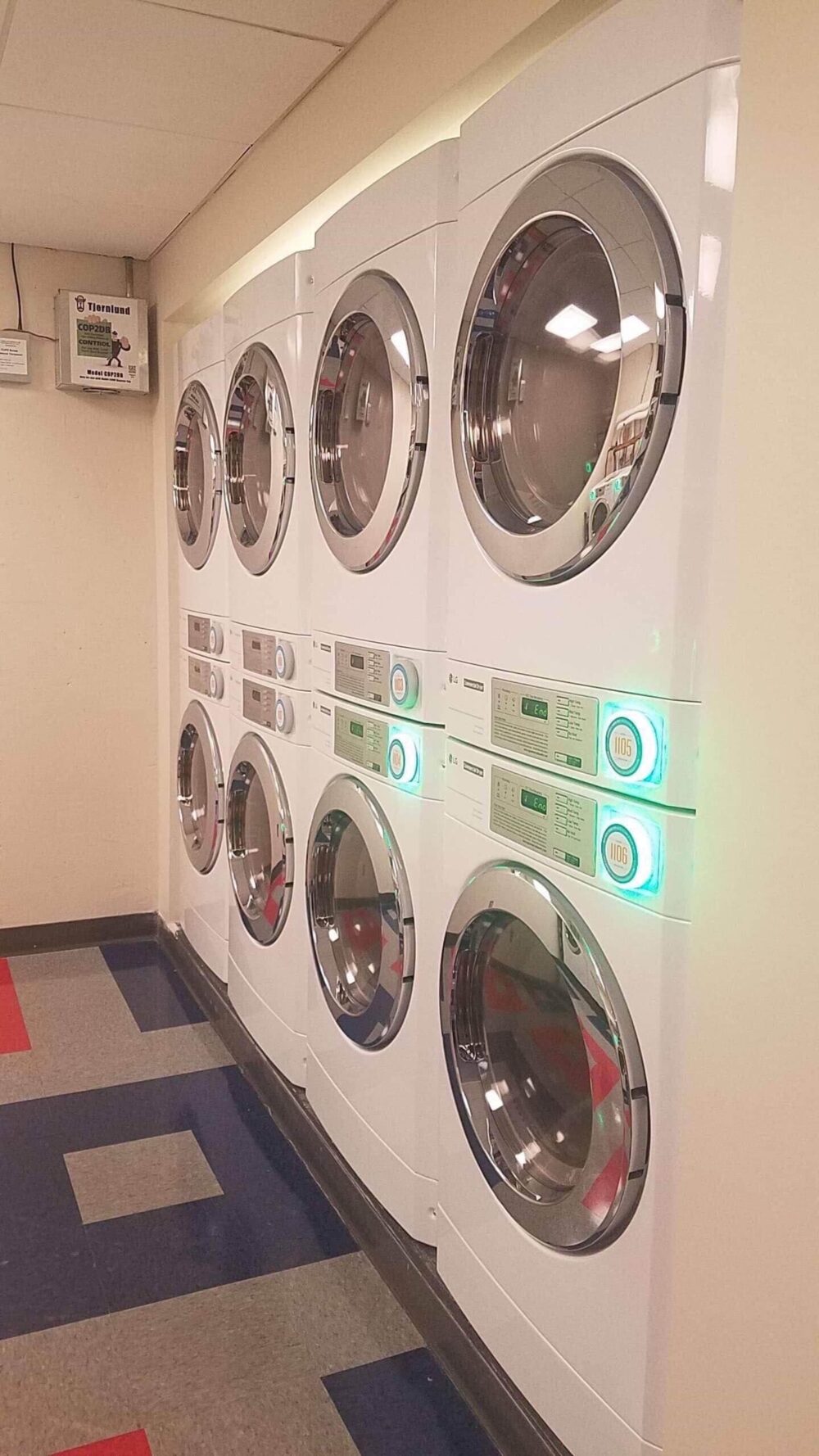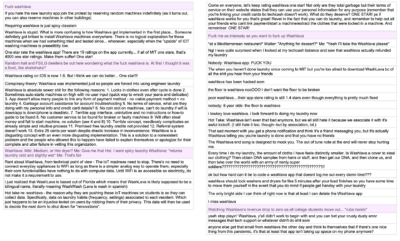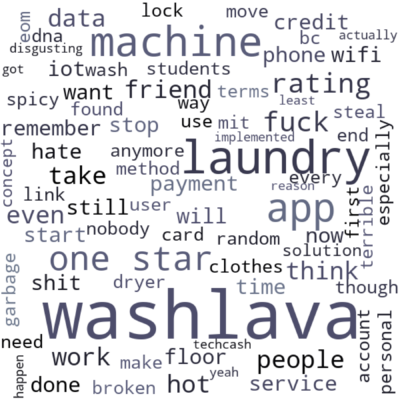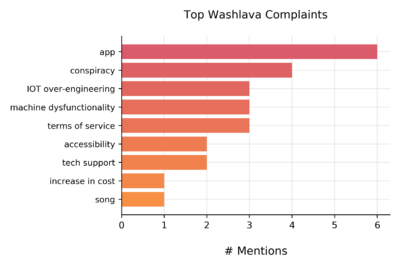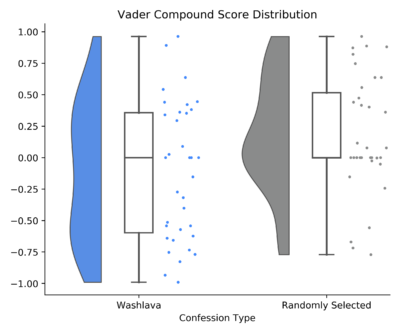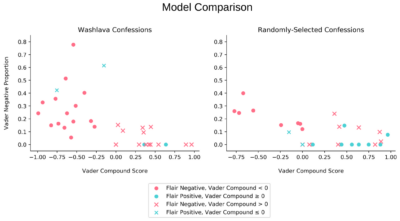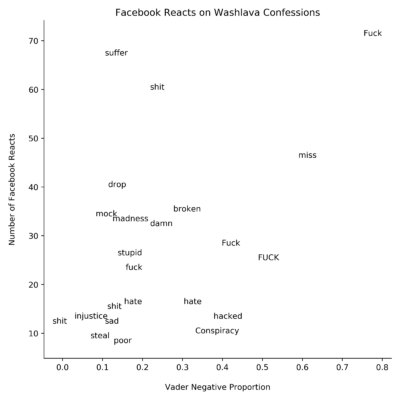
Washlava! A Sentiment Analysis by Kathleen E. '23
quantifying laundry feels, based on MIT Confessions
In 2019, MIT swapped out all of their coin-operated laundry machines with “Washlava,” a laundry platform consisting of IoT-connected machines. In this blog you’ll find two things: (1) my introduction to Washlava and (2) an analysis showing how MIT students felt about Washlava based on anonymous MIT Confessions.
1. A summer discovery
In my freshman year living in MacGregor House, I used to live relatively far from the laundry room, in a part of the building with no elevator.01 the low-rise (specifically, H Entry) It wasn’t a huge deal, but it did make it extra inconvenient if I lugged my hamper all the way to the laundry room and then there were no machines available, or I had forgotten something (tide pods, dryer sheets, quarters) and had to go back to my room.
Over the summer between my freshman and sophomore year, MIT decided to “deep clean” MacGregor. This meant that, for the first time in years, MacGregor would not host summer residents02 Except the GRAs (Graduate Resident Advisors) and other house staff who live in MacGregor year-round or provide summer storage.03 I didn't have a ton of good reasons for choosing MacG, but this was supposed to be one of them. I ended up having to pay for a storage facility in the area. I’m still pretty salty about the lack of free summer storage, because I checked the basement (where students would ordinarily store their things) when I moved back into MacG in the fall and it was as dusty as ever.
I and many other members of my freshman-year suite stayed in Boston over the summer. We were curious about how the deep cleaning was going, but we weren’t sure how to get inside MacGregor to check it out. Our ID cards, which normally give us door access, were deactivated for the summer. In mid-August, one of my suitemates decided to try his ID anyway, and it worked! I biked over and we explored the building. It was underwhelming. The floor didn’t even look vacuumed.
The one big difference was the laundry room. It was brand-new. Every machine was shiny, scratch-free, and equipped with a mysterious glowing button.
I was pretty excited about this. I thought, at the time, that only MacGregor had gotten new laundry machines, but it turned out that almost every dorm04 Random Hall kept their old laundry machines did. As school began, we were told that these new machines were part of the “Washlava laundry platform” and were told to install the corresponding app.
For the first two weeks of my sophomore year, the machines and the app kept malfunctioning. There were a variety of issues, and The Tech05 MIT's newspaper wrote an article about it.
Once everything was finally operational, I actually liked the machines a lot. I had moved to a different part of MacGregor06 the high rise (specifically, D Entry) where I was a lot closer to the laundry room and had access to the elevator. This, combined with Washlava, ultimately did make laundry a lot more convenient. I could check if there were machines available, temporarily reserve machines, pay without coins, and check on the status of machines I was using. Plus, no more lugging my hamper across the building and up three flights of stairs! I loved Washlava.
However, this turned out to be a divisive opinion.
2. Analysis of MIT Confessions
Since the Washlava was installed, there have been 32 posts made anonymously about it on “MIT Confessions” (a public Facebook page) and 3 more on private confessions page. I decided to collect data on these Washlava-related confessions and analyze them to answer:
- What exactly do people dislike about Washlava?
- How did the sentiment about Washlava confessions quantitatively compare to “typical” confessions?
i. Confessions data
Here are the Washlava-related confessions, ordered by date, with highlights added to mark my personal favorites:
There are a few confessions calling for 1-star ratings. This effort seems to have been successful. As of writing this post, the Washlava app has a 1.4 star rating (with 191 ratings) on the App Store.
ii. Word cloud
Normally, I dislike word clouds. I decided to make one anyway to roughly highlight what people were saying:
iii. Main complaints
I counted the number of times each topic was criticized in the confessions:
Some thoughts:
- The app complaints were valid; I’m sure many MIT students could write a better app. Perhaps this is what fueled so many complaints about the issues with the app.
- My favorite category was conspiracy. People speculated that “someone definitely got bribed to install Washlava” and that “the reason why they are pushing these IoT machines on students is so they can collect data… on laundry habits… associated with each resident.” Another joked about Washlava being “a cover to steal out clothing… obtain DNA samples… and then clone us.” I wish all of these were true.
- Honorary mention for this tech support complaint: “You can bet your crusty dusty error messages that tech support or whatever didn’t do shit.”
iv. When were people most dissatisfied?
I looked at when Washlava-related confessions were posted throughout the year and observed:
- Washlava confessions drop off in late November. I hypothesize this is because people got too busy stressing about finals-season to complain about laundry.
- After a period of no Washlava confessions, three were posted in mid-March, when undergraduates were evicted from MIT due to COVID-19. I was
surprised07
This is what made me interested in analyzing the data
that in the midst of all the chaos and loss, people had the bandwidth to continue making Washlava confessions, but they were pretty funny:
- (152 reacts) The only bright side I can think of right now is that at least I can delete the Washlava app
- (46 reacts) I miss washlava
- (40 reacts) Watching Washlava’s revenue drop to zero as all college students move out… rubs hands
v. Making a control group
In order to make comparisons between Washlava confessions and typical confessions content, I collected an additional dataset consisting of 35 randomly-selected confessions, all from within the same time period as the Washlava confessions. Since each confession is posted with a unique number, it was straightforward to select the control data. I generated 35 random numbers between the number associated with the earliest and latest confessions I pulled.08 Since the majority of the Washlava confessions came from the public confessions page, I ignored the private page for this step. To get the actual confession from the number, I just had to search the number on the MIT Confessions page.
vi. Sentiment analysis models
Sentiment analysis is a sub-field of natural language processing that interprets emotions within a text. I used two simple models to extract sentiment:
- Vader (Valence Aware Dictionary for sEntiment Reasoning),09 Available through NLTK a lexicon and rule-based tool developed in 2014 specifically attuned for use on social media content. It returns the proportion of text that fall into each of three categories: positive, negative, and neutral. It also provides a compound score (a sum of normalized lexicon ratings) ranging from -1 (very negative sentiment) to 1 (very positive sentiment).
- Flair, a sentiment classifier based on a character-level LSTM neural network. Unlike Vader, it doesn’t provide any measure of positive or negative sentiment within the text – it just classifies the text as “Positive” or “Negative” and a confidence for its classification. I used it mainly to get a second machine opinion on the sentiment of each confession. Flair can make predictions about the sentiment of “out-of-vocabulary” words, unlike Vader, which classifies these as neutral.
vii. Overall proportion of sentiment
For each group (Washlava and randomly-selected), I combined all of the text and used Vader to measure the overall proportion of negative and positive sentiment within each dataset. If we consider the randomly-selected confessions as the “typical” sentiment of confessions, then this plot shows that the Washlava confessions had a higher-than-average proportion of negative sentiment and a lower-than-average proportion of positive sentiment.
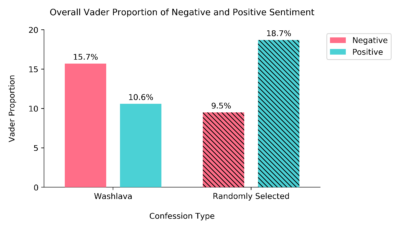 Flair seemed to agree that Washlava was more negative than typical confessions. Flair classified 88% of Washlava confessions as negative, as compared to only
62% of the control group confessions.10
The fact that the majority of the randomly-selected confessions were classified as having negative sentiment doesn't surprise me; MIT Confessions can be pretty toxic at times.
Things aren’t looking great for Washlava at this point.
Flair seemed to agree that Washlava was more negative than typical confessions. Flair classified 88% of Washlava confessions as negative, as compared to only
62% of the control group confessions.10
The fact that the majority of the randomly-selected confessions were classified as having negative sentiment doesn't surprise me; MIT Confessions can be pretty toxic at times.
Things aren’t looking great for Washlava at this point.
vii. Examination of compound scores
Next I wanted to get more granular and look at the distribution of sentiment metrics for individual confessions.
Vader provides a compound score, which is a measure of sentiment ranging from -1 to 1 calculated by taking a sum of normalized lexicon ratings for word in a text. I calculated the compound score for each confession and made a raincloud plot. Although both groups had a median compound score of 0, the means trended in the desired direction: -0.12 for Washlava confessions and 0.18 for the randomly-selected group.
The distribution surprised me. I didn’t expect to see so many positive compound scores in the Washlava category since Flair classified 88% of Washlava confessions as negative. In the raincloud plot above, only 48% of the Vader compound scores were negative.
To investigate this, I plotted the Vader compound score against the proportion of negative text for each confession. The shape of the points show where the Vader compound score and Flair classification agreed (circle-shaped points) and disagreed (x-shaped points). The color shows the Flair classification (green is positive, red is negative).
In the left-side Washlava plot, you can see from all the red x’s that Vader often gave positive compound scores to confessions that Flair classified as negative. Meanwhile, in the right-side plot, more of the confessions with positive compound scores were also classified as positive by Flair, as seen by the green dots. This plot helps highlight differences in the raw data points in the raincloud plot above which otherwise might look similar.
Along with what was observed in the previous section, at this point it seems that the overall MIT-confessions-reaction to Washlava was quantitatively negative, both relative to a randomly-sampled control group and according to the Vader lexicon ratings.
viii. Facebook reacts and negativity
Did the quantity of Facebook reacts trend at all with negativity? Perhaps, according to this plot of the proportion of negative words in a confession by the number of Facebook reacts it received. Instead of points, I displayed the most negatively-rated word according to the Vader lexicon. If a confession did not have any negatively-rated words, it was not included on this plot.
I feel like if Washlava was installed now, there wouldn’t be much of an uproar. In recent months, MIT students have had to collectively confront much more serious domestic and global issues. I generally support voicing concerns, no matter how small, but analyzing these confessions did remind me how much of a bubble campus provides to shield many of us from greater worries. It is such a privilege to complain about a brand-new laundry system.
- the low-rise (specifically, H Entry) back to text ↑
- Except the GRAs (Graduate Resident Advisors) and other house staff who live in MacGregor year-round back to text ↑
- I didn't have a ton of good reasons for choosing MacG, but this was supposed to be one of them. I ended up having to pay for a storage facility in the area. back to text ↑
- Random Hall kept their old laundry machines back to text ↑
- MIT's newspaper back to text ↑
- the high rise (specifically, D Entry) back to text ↑
- This is what made me interested in analyzing the data back to text ↑
- Since the majority of the Washlava confessions came from the public confessions page, I ignored the private page for this step. back to text ↑
- Available through NLTK back to text ↑
- The fact that the majority of the randomly-selected confessions were classified as having negative sentiment doesn't surprise me; MIT Confessions can be pretty toxic at times. back to text ↑
